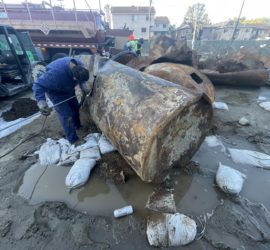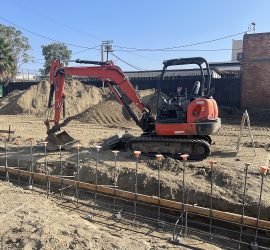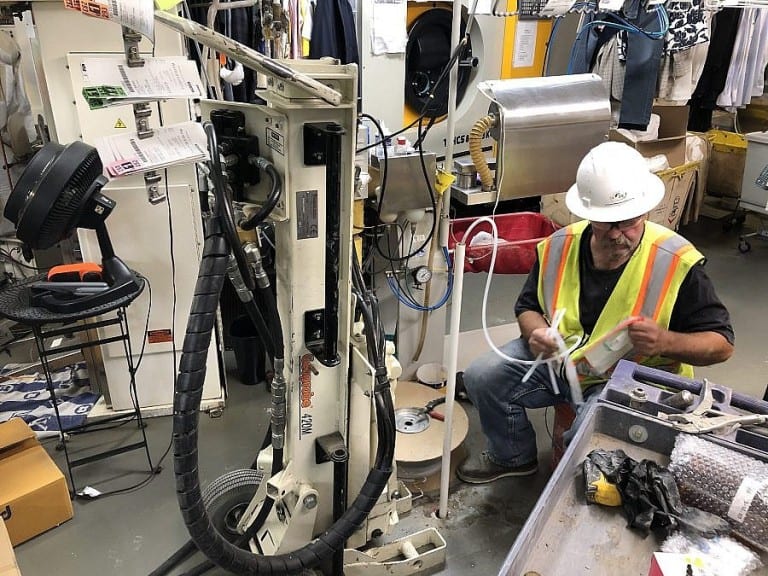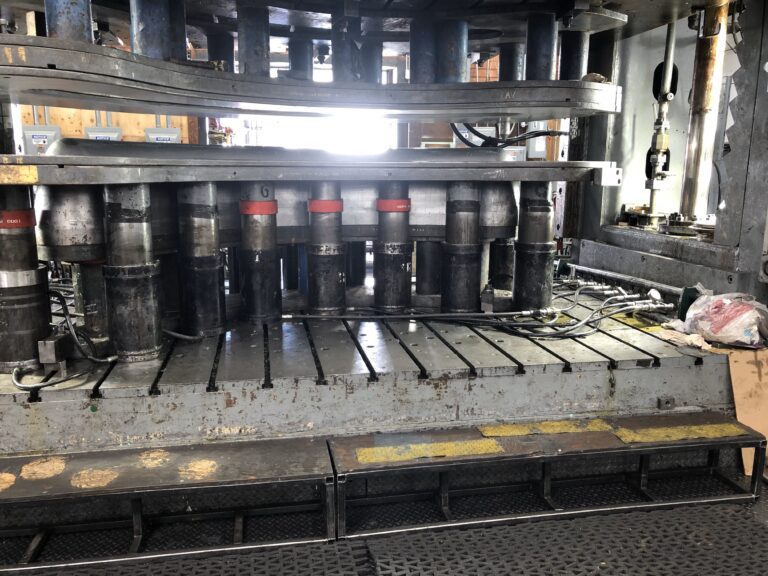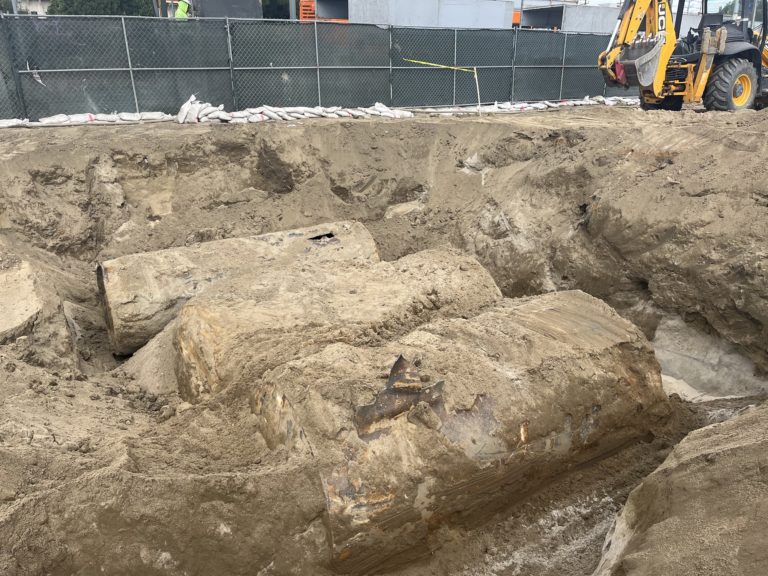Underground Storage Tank Sizes & Volumes
There are a variety of underground storage tank sizes and volumes. Usually, a UST size relates to the purpose, location, and content of the container. For instance, some underground diesel fuel tanks can have lengths up to 55 feet and hold as much as 30,000 gallons. Whereas waste oil storage tanks can be as little as 3 feet long, and hold just 55 gallons. Evaluating the purpose of the UST, referencing as-built plans with building permits, and performing a geophysical survey can help determine the size of any UST. Updated April 17, 2024.
Underground tank manufacturers have been producing USTs for commercial and residential purposes since the early 1900s. While diesel or gas station USTs are some of the most common large-scale applications, smaller USTs are also built for small businesses, auto repair shops, and homes.
For instance, a typical truck stop can maintain up to a dozen diesel USTs as large as 20,000 and 30,000 gallons. Modern gasoline service stations usually include two or three gasoline tanks from 10,000 to 20,000 gallons each. Moreover, an auto repair shop that generates waste motor oil usually has one UST ranging anywhere from 150 to 1,000 gallons. And the Boyle Dayton Company and the Sylvanus Freelove (S.F.) Bowser Company both produced small-scale gasoline USTs and pumps anywhere from 50 to 100 gallons, for farm homes and convenience stores.
The table below demonstrates the dimensions of the standard size of USTs across North America, as well as their volume and weight.
Standard UST Sizes, Volumes, and Weight | ||
| UST Dimensions | UST Capacity (Gallons) | Estimated Steel UST Weight (Pounds) |
| 2.5’ x 4’ | 150 | 260 |
| 3’ x 5’ | 300 | 340 |
| 4’ x 6’ | 550 | 745 |
| 4’ x 7’ | 600 | 975 |
| 4’ x 11’ | 1,000 | 1,235 |
| 6’ x 6’ | 2,000 | 2,200 |
| 6’ x 13’ | 2,500 | 2,650 |
| 6 x 17’ | 3,000 | 3,000 |
| 6’ x 20’ | 4,000 | 3,550 |
| 8’ x 13’ | 4,000 | 3,150 |
| 6’ x 25’ | 5,000 | 4,350 |
| 8’ x 17’ | 5,000 | 3,600 |
| 6’ x 30’ | 6,000 | 5,100 |
| 8’ x 20’ | 6,000 | 4,050 |
| 8’ x 25’ | 8,000 | 5,000 |
| 8’ x 30’ | 10,000 | 5,950 |
| 10’ x 21’ | 10,000 | 7,500 |
| 8’ x 36’ | 12,000 | 7,050 |
| 10’ x 24’ | 12,000 | 8,600 |
| 8’ x 44’ | 15,000 | 9,350 |
| 10’ x 29’ | 15,000 | 10,500 |
| 10’ x 37’ | 20,000 | 13,550 |
| 10’ x 46’ | 25,000 | 17,100 |
| 10’ x 54’ | 30,000 | 20,400 |
| 10’ x 63’ | 35,000 | 24,350 |
| 10’ x 71’ | 40,000 | 27,750 |
| 10’ x 80’ | 45,000 | 31,250 |
| 10’ x 88’ | 50,000 | 34,750 |
Typical UST Materials
Underground Storage Tanks (USTs) containing hazardous materials are usually single to triple-wall steel, fiberglass, or polymer containers. In fact, some USTs have multiple walls made from a combination of these materials. Since the early 1900s, most UST applications were single-wall steel tanks. Over time, manufacturers began using other materials for cost-effectiveness, corrosion protection, longevity, and leak protection.
Identifying Underground Storage Tanks on a Property
The type of operation or land use, historical or concurrent, as well as the contents of the UST, can be good indicators of its size.
Identifying USTs in a Phase 1 ESA
During a Phase 1 Environmental Site Assessment, professional geologists and environmental technicians identify locations of hazardous waste containing USTs. Whether the existing USTs are known, unknown, or presumably in place, the Phase 1 ESA process entails visual and paperback investigations into the history of a property. For instance, an environmental professional reviews historical building permits, demolition permits, disposal records, and more to identify underground storage tank sizes and volumes. Per the American Society for Testing and Materials (ASTM) Standard Practice for Phase 1 ESAs, even the mere possibility of a UST can be a Recognizable Environmental Condition (REC).
How to Determine the Size of an Underground Storage Tank
During the Phase 2 Environmental process, a geophysical survey can also identify most underground storage tank sizes and volumes. This process involves using electromagnetic induction (EM), magnetometry, and ground-penetrating radar (GPR) to detect and delineate UST dimensions. As a result, field geologists can mark the footprint of each underground storage tank size, on the ground surface. And using depth information, one can approximate the UST size and volume.
Removing an Underground Storage Tank on Property
Underground storage tank removal processes must occur in accordance with the proper environmental protocol, and the oversight of regulatory agencies. Additionally, underground tank removal contractors require special geology, toxicology, construction, disposal, and transportation licenses. And in order to prepare UST removal permits, it is important to know each tank’s location, depth, content, and size.
How deep is the Top of an Underground Storage Tank?
The depths to the top of an underground storage tank can vary depending on its type and purpose. However, average top-of-tank depths are roughly 2 feet to 3 feet below the ground surface. Regardless, modern fuel tanks are stronger and have depth ratings up to 5 feet below the ground surface.
Average UST Depths
The average burial depth rating increases as conventional USTs get larger. Although, at many gasoline service stations today, the tops of the buried underground storage tanks remain between 2 feet and 3 feet below the ground surface. Occasionally, larger USTs may be observed with the top of the tank as deep as 7 feet below the ground surface. And sometimes, USTs for the purposes of burying hazardous waste is between 10 feet and 100 feet below the ground surface.
Authors:
Written By: Michael Joseph Sabo
Edited By: Adam Azad Kaligi, PG

